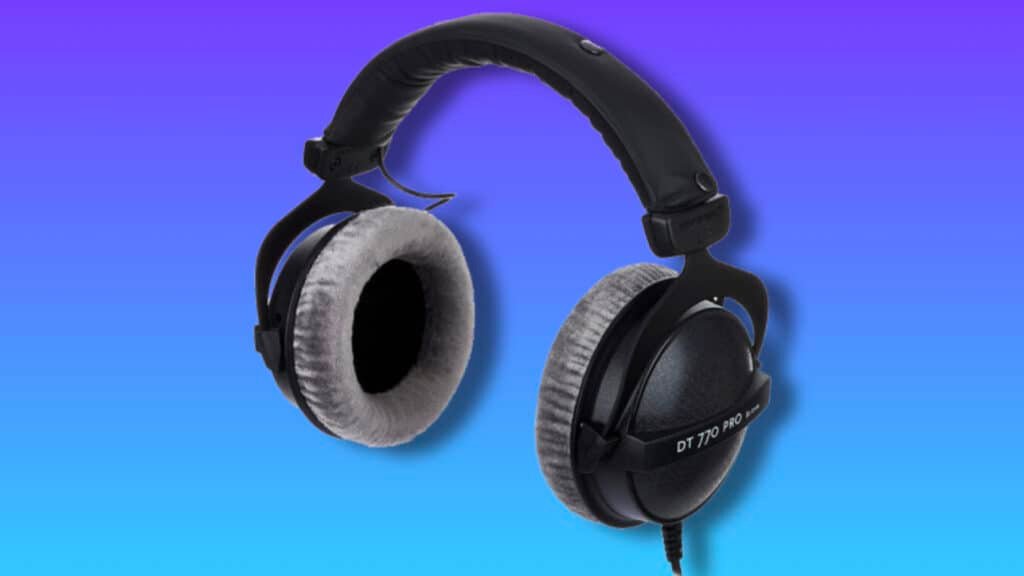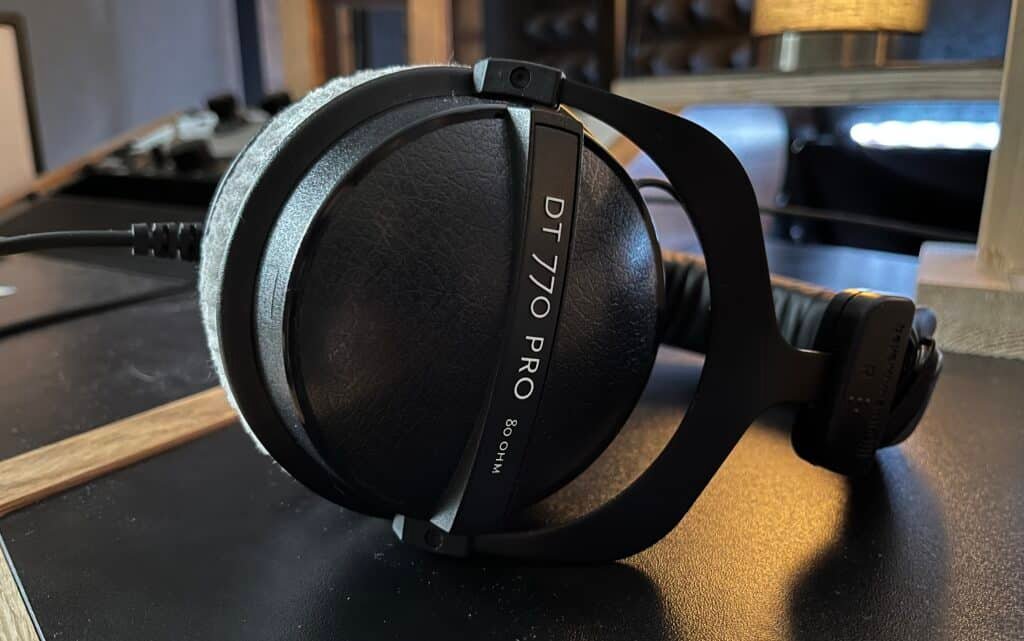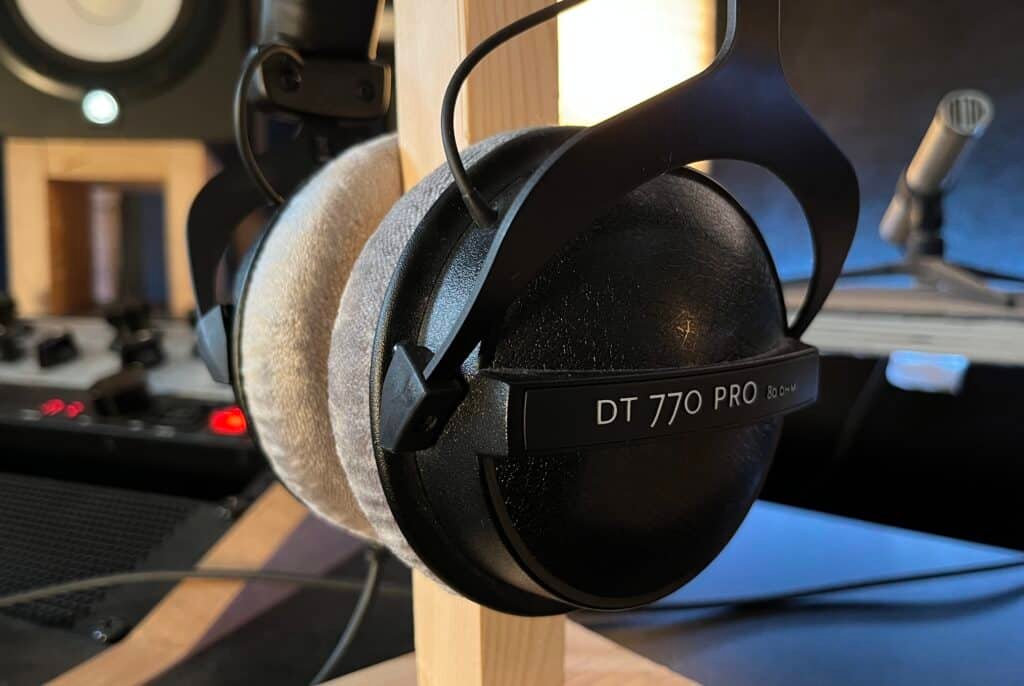The Beyerdynamic DT-770 are one of the most used headphones in the studio world since many years. They can be found literally everywhere. But why are these headphones so popular ? Can they still be considered the number one in 2023 ? In my opinion, yes, and I’m going to give you 6 reasons why the DT-770 are still the best studio headphones.

The Beyerdynamic DT-770 headphones remain at the top thanks to the following reasons :
- They are comfortable to wear
- The price remains unbeatable
- They are robust
- The frequency response is pleasant
- Almost every component is replaceable
- They have ohm variants
1. They are comfortable to wear
This might seem like a very trivial benefit, but studio headphones are meant to be worn for hours and hours on end. So having uncomfortable headphones on your head is definitely something to avoid.
Many headphones fall into the category of really uncomfortable headphones. The Sennheiser HD-25, for example, is in my opinion the worst in terms of comfort. But with its large circumference around the ear and its very soft foam, the DT-770’s listening experience becomes much more pleasant.
The top of the head area is also designed for maximum comfort. In fact, even if you wear these headphones for hours, you’ll never have any pain anywhere on your head. Its foam surrounded by leather (which gives it a very vintage look) will mold itself to your head very easily.
After a few minutes, your brain will completely forget that it’s on your head.
For advanced sound engineers who already have clients in their studios, this is a big plus. I can’t even count the number of times an artist has said to me at the beginning of a session, “Wow, these headphones are really comfortable.
And when that happens, you know you already have the artist in your pocket, even before they’ve heard a single note in the DT-770.

2. The price remains unbeatable
Generally, when a product becomes internationally recognized the prices tend to increase.
But since its creation (in 1981, it seems to me), Beyerdynamic has always known how to adapt its prices to make it accessible to everybody. From professional sound engineers to novice music producers, Beyerdynamic knows how to please a large audience. Today, you can find these headphones almost everywhere (Amazon, Guitar Center, SweetWater,…) at the price of 159$.
This price is affordable for anyone, even amateurs, aspiring to the world of music production. For this small amount of money, you’ll be able to boast that you’re using the same headphones as many audio pros!
There are obviously other studio headphones in this price range, but, in my opinion, with a less advantageous price-performance ratio. The ATH-M50x from Audio-Technica, for example, is less reliable in its sound, less comfortable and less robust. Having experienced it as well, I also had the chance to see the leather decompose after a few months, and it is irreplaceable (or hardly so). Nice life!
This further supports the fact that, for $159, the DT-770 is clearly the best choice when it comes to studio headphones.

3. They are robust
Buying a product that lasts is an extremely important part of any purchase, and the DT-770 is no match for its competitors. By buying the Beyerdynamic headphones, you can expect to keep them for at least 10 years in a good and usable condition.
Personally, my first DT-770 is about 8 years old, and the only thing that is slightly damaged is the foam around the ears. It has simply blackened, nothing more!
When you take this headphone in hand to put it on your head, you understand immediately that it is built to last in time. In fact, it has an ideal elasticity at the head level and an incomparable robustness at the ear level.
Despite the “crrrrck” that you can sometimes hear when you put them on your head, you will never get close to any breaking point.
4. The frequency response is pleasant. But…
For many sound engineers, producers and musicians, frequency response is a key factor in choosing studio headphones. This makes sense since we all want to have a reliable listening experience that we can trust every time we listen.
That’s why this will be the most thoroughly explored point.
Let’s analyze the frequency response below :

To facilitate our analysis, we will focus on 4 frequency bands which are highlighted below :

A. Solid bass range
We all love bass. In music, it allows us to put all the sound elements on a solid base, to make us travel and to make our guts move!
Too much bass, on the other hand, can become oppressive and mask all the other frequencies. While a lack of bass can give an impression of emptiness and lack of body.
But with the DT-770, the bass is slightly boosted, without being excessive, for the best possible sound experience. These headphones also have what few headphones can provide, sub-bass.
In addition to being able to deliver those ultra-low frequencies, it does so in a very solid and stable way. Of the many headphones I’ve tried over the past few years, no other headphones have given me the low-end pleasure of the DT-770.
B. Reliable low-mid range
In music mixing, the low-mid range is a very difficult frequency area to control. Too much boosted, this frequency range can make your mix completely muddy. Too much cut, and you will have an unnatural feeling of distance from your source.
That’s why taking advantage of headphones that allow you to have a super reliable frequency response in this area can make your job easier than you think. This is exactly what the DT-770 will give you, stability and reliability in the low-mid range.
Indeed, you can see that, in the area highlighted in yellow, the frequency response is completely flat. For me, this is a big advantage for the listening comfort.
C. Slight hole in the mid range
In green, you can see a slight hole in the frequency response in the area between 1.5 kHz and 4 kHz. For many, this can be a big disadvantage because you potentially lose the whole presence area which is very important to emphasize in music mixing.
But in my opinion, and this is due to my status as a mixing engineer, it is an advantage. Indeed, when I switch from my speakers to my DT-770, I will instinctively push a little more this frequency zone, which will give more presence to my voices and make them cut through the mix.
But…
D. Aggressive high-mid range
In terms of frequency response, the high-mid range is probably the biggest flaw of the DT-770. In this area, the boost is indeed very pronounced but also very tight.
This hump in the 8kHz area is the main reason why many people prefer to opt for competitors of the DT-770. This is understandable, as this hump boosts an area to which the human ear is very sensitive. Sibilance, snares and hi-hats can quickly sound aggressive, especially at louder levels.
This has the “advantage” that you’re warned as soon as any flaws are present in this frequency area. So you will probably never miss, for example, de-essing problems with your vocal tracks.
But besides these frequency analyses, the most important thing is the feeling and the listening experience. And in this specific field, the DT-770 is one of the best on the market. It has everything to please, whatever your taste in terms of frequency.
You’ll get a sub-bass that’s not excessive but very solid. The mid-range will be extremely reliable and its transparent rendering will give you an incredible feeling of immersion. And its accurate high-end range will allow you to work this area with maximum accuracy.
5. Almost every component is replaceable
Having a sturdy pair of headphones is one thing, but being able to replace the parts separately is another. The DT-770 is almost unbreakable, but you can never be sure that a drop or a blow will not break one of the headphone’s components.
But if you buy these headphones, don’t worry, Beyerdynamic has you covered! You won’t have to pay for a whole new set of headphones if just one part is broken or defective.
Almost every part of the DT-770 is replaceable by a new one. They may not be easy to find, but with a little research, you will probably find a replacement for the component of your headphones that no longer works.
In the long run, this can be a huge money saver!
6. They have ohm variants
These headphones have an advantage that none of the others in this range have: ohm variants. As a reminder, the ohm is the unit of measurement for impedance. Simply put, the higher the input impedance, the more resistant the device will be to the input signal. This will also slightly change the coloration you will hear in your ears.
With the same source at the same volume, each sub-type of headphone will vary the listening volume according to the impedance it has.
In the case of the DT-770, it is divided into 3 types :
A. 32 ohm
In this version of the DT-770, the impedance is quite low. So you won’t need a lot of power to have a correct volume in your ears.
The 32 ohm is ideal for use with consumer devices like laptops or smartphones. If you don’t have an interface in your home studio, this is clearly the best option! Beyerdynamic also recommends it for all applications that are related to DJing.
B. 80 ohm
The 80 ohm is the best known variant, for the simple reason that it is versatile. In the home studio, it is the ideal impedance for headphones.
All interfaces available on the market will be able to deliver enough power to get a comfortable level in the ears.
C. 250 ohm
250 ohm is a pretty high impedance for headphones. It will therefore require a relatively high power to deliver an ideal volume to the user’s ears.
This solution is ideal if you consider mixing, mastering or recording more than just a hobby and your studio is reasonably sophisticated.
Most interfaces will deliver enough level. But it will still be more comfortable to use this version of the DT-770 with a professional headphone amp.

The Beyerdynamic DT-770 also have flaws
But the DT-770 headphones might also have some flaws, including the fact that…:
1. They can lack openness
This is the classic fault of closed-back headphones: they lack openness and can quickly give a feeling of enclosure. This is due to the fact that the sound cannot escape from the outside but only into the ears of the user.
ℹ️ You want to know the difference between closed-back and open-back headphones? You have everything you need here: Closed-Back vs Open-Back Headphones: What Is The Difference?
2. The bass range may sound messy with certain genres
Also due to the fact that the DT-770 are closed-back headphones, the low-mid and bass range can sometimes be perceived as quite messy in the user’s ears.
As the sound cannot escape through the outside of the shell, slight reflections can occur inside the headphones. And it is in the lowest frequencies that this will be the most noticeable.
When working on genres such as rap, pop or EDM, where the bottom is usually boosted, this messy side can be very disturbing.
3. They can quickly lead to ear fatigue
Despite the comfort, I have noticed in recent years that the DT-770 can quickly become tiring for the ears. This is largely due to the high-mid range boost in the frequency response.
It is important to keep in mind that the human ear is very sensitive to this frequency range. This explains the fact that the DT-770 can still be tiring after several hours of use.
Conclusion
The DT-770 headphones have everything to please. They are comfortable, they are robust, they are cheap, they are very neutral and their ohm variants make the Beyerdynamic headphones one of the best selling studio headphones in the world. Despite more than 30 years in the sound business, the DT-770 never gets old. It remains a classic and the favorite of many top producers, musicians and sound engineers.
For all these reasons, and despite the 3 flaws mentionned in this article, the DT-770 remains in my opinion the best studio headphones in 2023. And maybe for a few more years!
If you have any question about these headphones or about music mixing, contact me, I’m always very happy to help!
Related Articles:
My favorite tools for mixing pop and hip-hop music:
Plugins
In the field of auto-tune, I’m convinced that nothing’s better and more efficient than Antares Auto-Tune Pro. As for the EQ’s, FabFilter Pro-Q3 and Slate Digital Infinity EQ are, in my opinion, the best tools. For compression, I have 2 favorites plugins: Waves RComp and UAD EL8 Distressor.
As for reverb, I’m a big fan of the Soundtoys Little Plate, but generally, I go for the Valhalla VintageVerb for its versatility. I also love the Arturia Rev PLATE-140 and the UAD Pure Plate for its organic side.
Headphones
The closed headphones I love and will always love using for mixing pop and hip-hop music are the Beyerdynamic DT-770. As for the best open-back headphones, I use the Sennheiser HD600 headphones, and I’m really happy of them!
Monitors
Having a pair of Yamaha HS7 in its studio or home studio is always cool for more excitement while listening to your mixes. The Adam Audio T7V monitors are also super accurate. In my studio, I also have a pair of Genelec 8030 for their reliability.
Hardware gear
For anyone who wants to start using hardware in their mixes, I always recommend these 2 units from Klark Teknik: the EQP-KT and the 76-KT. Don’t forget to use good converters, such as the Apollo interfaces. This is essential for a good rendering.






